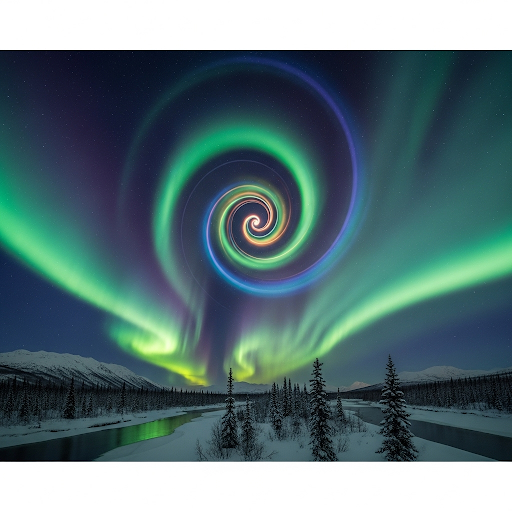Mysterious Green Spiral in the Night Sky Over Alaska : UFO or Rocket Test?
A luminous green spiral lit up the Alaskan night sky, sparking UFO theories and viral videos worldwide. Was it an alien craft, a portal, or something more earthly? Here’s the science and the history behind the breathtaking display.

Alaska has seen its share of spectacular auroras, but what lit up the night sky last night was unlike anything most locals had ever witnessed. Across multiple towns and remote outposts, people stepped outside to catch the shimmering curtains of green from the aurora borealis only to find something else spinning in the heavens: a luminous, almost perfectly formed spiral of light, rotating slowly as if suspended in space. Within hours, the footage flooded social media feeds, sparking headlines and speculation.
Was it a UFO? A wormhole opening above the Arctic Circle? Or something much more earthly but no less fascinating?
Let’s break down what people saw, why it looked so otherworldly, and the science behind these mysterious spirals that seem to appear every few years.
What Eyewitnesses Saw
The earliest clips surfaced just before midnight Alaska time. In them, the aurora was already in full swing green bands rippling across the sky, glowing brighter in bursts. But in one section of the horizon, a strange light appeared: a bright dot that expanded into a ghostly swirl.
Some described it as looking like a galaxy photographed through a telescope, but visible with the naked eye. Others called it a “celestial portal” or “spinning UFO.” In real time, the spiral took several minutes to fully form, spinning slowly as it drifted across the stars. For those who had cameras running, long-exposure shots made the spiral appear even more defined and luminous, almost like a piece of cosmic artwork unfurling in slow motion.
And then just as suddenly it faded, leaving only the aurora behind.

Why the Spiral Looked So Strange
The unsettling beauty of the spiral comes from a combination of two very different phenomena: the natural glow of the aurora and the physics of high-altitude exhaust plumes.
The aurora borealis happens when charged particles from the Sun collide with Earth’s magnetic field and funnel toward the poles. These particles interact with atmospheric gases oxygen for green, nitrogen for pink or purple creating shimmering light at altitudes of 80 to 200 kilometers. On a strong aurora night, the entire sky can glow with shifting patterns and curtains of light.
Now, imagine a man-made event a rocket stage venting leftover fuel, for example—occurring in the same part of the sky. At high altitudes, any vapor or gas released spreads quickly into a vast cloud. If the rocket or object is rotating, the gas is released in a spiral pattern, expanding as it moves outward. The ice crystals or particles in the plume reflect sunlight from just beyond the horizon, making the spiral glow brightly even when the ground below is in darkness.
When that glowing spiral drifts in front of a vibrant aurora, it becomes almost impossible for the human eye or even the skeptical mind not to register it as something alien.
This Has Happened Before
As bizarre as it sounds, Alaska and other high-latitude regions have seen similar spirals before. Several past cases were later linked to known rocket launches, reentries, or missile tests:
- In 2023, a nearly identical spiral appeared over Alaska and was traced back to a rocket launch whose second stage vented excess fuel over the Arctic.
- In 2009, Norway witnessed a dramatic blue spiral caused by a failed missile test, which created a massive plume shaped by the rotation of the tumbling rocket stage.
- In recent years, observers in Hawaii, New Zealand, and parts of the continental U.S. have reported smaller spirals tied to satellite deployments or upper-stage fuel dumps.
These events are rare for any given location, but because rockets are launched worldwide almost daily, there’s always a chance one will create the right conditions for a viral spectacle.
How Experts Figure It Out
When something like this happens, atmospheric scientists, astronomers, and spaceflight trackers usually go through a quick checklist to determine the cause.
- Timing and Trajectory
They compare the time of the sighting to scheduled rocket launches or satellite deployments. Most launches are publicly listed, and orbital paths can be calculated to see if they match the location of the spiral. - Appearance and Behavior
A spiral that forms and grows over several minutes, with a central bright point and symmetrical arms, is almost always caused by a rotating object venting gas at high altitude. The shape, speed, and fading pattern provide more clues. - Lighting Conditions
These events often occur when the object is in sunlight while the ground is dark common in polar regions during certain times of year. The light scatters through the plume particles, creating an almost ethereal glow.
Past Comparisons
Researchers cross-check with known images and videos from past events to confirm the match.

Why People Jump to “UFO”
Despite the very terrestrial explanations, spirals almost always get tagged as UFO sightings in their first hours online. That’s partly because the visuals are so unlike the “everyday” sky, but it’s also because the internet loves mystery. A spinning spiral over the aurora makes for a perfect viral clip especially if someone adds a suspenseful soundtrack or captions it as “portal opening” or “unidentified aerial phenomenon.”
The truth is, our brains are wired to look for patterns, and spirals are one of the most hypnotic patterns in nature. Combined with the allure of space and the unknown, they trigger a flood of fascination and suspicion.
Could It Be Anything Else?
While rocket exhaust plumes are the most common explanation for these spirals, there are other possible causes:
- Missile Test Failures
If a missile’s stage malfunctions, it can spin while releasing exhaust, producing a similar spiral. These cases are rarer but have occurred, most famously in the Norway event of 2009. - Satellite Reentry
A large satellite breaking up in the atmosphere could theoretically produce a spiral, though debris paths usually look more like streaks or multiple trails than a single neat swirl. - Atmospheric Phenomena
In extremely rare cases, ice crystal formations in high-altitude clouds can create unusual light shapes when illuminated by a bright source, but a perfect spiral is unlikely without mechanical rotation involved.
The Science Behind the Spiral
If you zoom in on the physics, here’s what’s happening step by step:
- A rocket or upper stage finishes its mission — for example, delivering a satellite into orbit.
- Leftover fuel is vented to avoid the risk of explosion when the stage reenters the atmosphere.
- The stage is rotating either intentionally for stability or due to small imbalances after separation.
- The vented fuel forms a plume in the near-vacuum of high altitude, expanding rapidly in all directions.
- Rotation shapes the plume into a spiral, as each release of gas is laid down at a slightly different position relative to the stars.
- Sunlight hits the plume even though it’s night on the ground, making it glow against the darker sky.
Aurora in the background adds extra color and makes the event even more dramatic.

It’s a textbook example of human engineering unintentionally creating something that looks like deep-space astrophotography.
What to Do If You See One
If you’re lucky enough to spot a spiral in person, here are some tips to document it and maybe help solve the mystery:
- Use a tripod if you have one; long-exposure shots will capture more detail.
- Take video to show the motion and duration.
- Note the time and location for later comparison with launch data.
- Look for expert commentary on local astronomy or science pages; they often post explanations within hours.
Why These Events Matter
Even when the cause is “just a rocket,” these spirals are a reminder of how connected our skies are to the space industry. Launches from halfway across the world can create visible effects over the poles. They also highlight how modern space activity is no longer rare; we live in an era when satellites, rockets, and space debris regularly cross our skies sometimes in dazzling fashion.
For scientists, these events are valuable because they offer a way to study how particles spread in the upper atmosphere. For the public, they’re a rare chance to see something extraordinary without leaving Earth.
The Bottom Line
The mysterious green spiral over Alaska is almost certainly the product of a rocket’s upper stage venting fuel against the backdrop of a bright aurora. While that may sound less thrilling than an alien spacecraft, it doesn’t make the sight any less awe-inspiring. In fact, the combination of human technology and natural beauty might be the real story here: our machines can create fleeting, cosmic-scale art, and the universe provides the perfect canvas.
And maybe that’s the magic—whether it’s a UFO, a rocket, or a rare natural trick of the light, for a few minutes on a cold night in Alaska, the sky opened up and reminded everyone looking up that we live in a world full of wonder.
Sources :
- Associated Press – “Rocket science: Alaska sky spiral caused by SpaceX fuel dump.”
- University of Alaska Fairbanks Geophysical Institute – “Giant spiral appears in Alaska sky.”
- Wikipedia – “2009 Norwegian spiral anomaly.”
- Fox Weather – Coverage and expert commentary on aurora + plume interactions.




